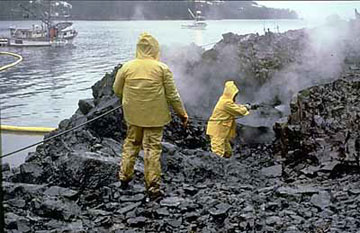Exxon Valdez oil spill more damaging to wildlife finds study
Exxon Valdez oil spill more damaging to wildlife finds study
mongabay.com
May 16, 2006
New evidence suggests that oil from the Exxon Valdez may still causing damage to Alaska’s Prince William Sound, 17 years after the ship ran aground.
The study, by chemist Jeffrey Short and colleagues at the National Marine Fisheries Service in Juneau, Alaska, appears today on the Web site of the American Chemical Society’s journal, Environmental Science & Technology, and is also scheduled to appear in the June 15 print issue of the journal.
“This study shows that it is very plausible that exposure to Exxon Valdez oil is having a material impact on many shore-dwelling animals and is contributing to their slow recovery in some parts of Prince William Sound,” Short said. “Sea otters, for instance, have yet to re-inhabit Herring Bay, the most oiled bay we studied, and the population of otters elsewhere around northern Knight Island continues to decline. Unfortunately, because much of this oil is buried in beach sediments and not exposed to weathering and other elements that might degrade it, it could remain hazardous to wildlife for decades.”
On March 24, 1989, the tanker Exxon Valdez ran aground on Bligh Reef in Prince William Sound, Alaska. Within six hours of the accident, the Exxon Valdez has spilled roughly 10.9 million gallons of its 53 million gallons of crude, making it the largest oil spill in U.S. history. The oil would eventually impact over 1,100 miles of non-continuous coastline in Alaska and at the height of the response, more than 11,000 personnel, 1,400 vessels and 85 aircraft were involved in the cleanup according to the National Oceanic & Atmospheric Administration.
 Workers using high-pressure, hot-water washing to clean an oiled shoreline. In this treatment method, used on many Prince William Sound beaches, oil is hosed from beaches, collected within floating boom, then skimmed from the water surface. Other common treatment methods included cold-water flushing of beaches, manual beach cleaning (by hand or with absorbent pom-poms), bioremediation (application of fertilizers to stimulate growth of local bacteria, which degrade oil), and the mechanical relocation of oiled sediments to places where they could be cleaned by wave and tide action. Photo courtesy of NOAA. |
While the cleanup effort began in April of 1989 and continued until September of 1989, Short and his colleagues found “significant amounts of Exxon Valdez oil buried in sand and silt that only becomes dry during the lowest tides.” The researchers say that this biologically diverse tidal zone is an important feeding ground for sea otters, ducks and other wildlife.
The findings are based on a survey of 662 pits randomly dug along 32 stretches of shoreline on northern Knight Island, one of the first affected areas during the spill. The researchers found Exxon Valdez oil at 14 of the 32 sites.
The researchers conclude that sea otters would be most affected by oil when they dig pits in search of clams and other prey. Short estimates that in a given year, a sea otter would probably come into contact with Exxon Valdez oil at least once every two months. This suggests that the Exxon Valdez oil spill could still be taking a toll on wildlife
Overall, in the immediate aftermath of the spill, scientists estimate that thousands of animals died. According to Wikipedia, some 250,000 sea birds, 2,800 sea otters, 300 harbor seals, 250 bald eagles, up to 22 orcas, and billions of salmon and herring eggs perished immediately.
This article is based on a press release fromthe American Chemical Society.